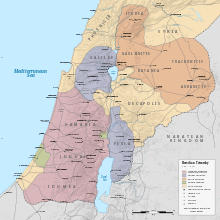Herodian tetrarchy
| Herodian tetrarchy | |||||||||||
|---|---|---|---|---|---|---|---|---|---|---|---|
| Tetrarchy of the Roman Empire | |||||||||||
| 4 BCE–44 CE | |||||||||||
 Territory under Herod Archelaus
Territory under Herod Antipas
Territory under Philip
Territory under Salome I
Herod Agrippa I (as King) | |||||||||||
| Historical era | Herod Agrippa I, his dominions annexed as a province Judaea | 44 CE | |||||||||
| |||||||||||
The Herodian tetrarchy was a regional division of a
Other parts of the Herodian tetrarchy continued to function under
Later Herodians, Herod of Chalcis, Aristobulus of Chalcis and Agrippa II, reigned over territories outside of Judea with the title of king but as Roman clients. The last of them, Agrippa II, died childless in c. 100 CE and thus all territories previously ruled by members of the Herodian dynasty were incorporated into the province of Syria.
Name
The word
History

| History of Israel | |
|---|---|
 | |
| 538–333 BCE | |
| Hellenistic period | 333–164 BCE |
| Hasmonean dynasty | 164–37 BCE |
| Herodian dynasty | 37 BCE–6 CE |
| Roman Judaea
Jewish-Roman Wars ) | 6 CE–136 CE |
At the time of his death, Herod ruled over most of the South Western
Because of Judea's status as a Roman
Eventually, after his death the kingdom was divided between three of Herod's sons:
- Idumeans).
- Perea.
- .
In a turbulent period of history, the rule of the tetrarchs was relatively uneventful. The most trouble fell to Archelaus, who was faced with sedition by the
Philip ruled Iturea, Trachonitis, Batanea, Gaulanitis, Auranitis and Paneas as a tetrarch until his death in 34 CE when his territories became briefly part of the Roman province of
See also
Notes
- ISBN 0-674-39731-2, page 246: "When Archelaus was deposed from the ethnarchy in 6 CE, Judea proper, Samaria and Idumea were converted into a Roman province under the name Iudaea."
- ^ Josephus, Antiquities XVII, 11 : 4
- ^ Luke 3 : 1
- ^ Cassius Dio, Roman History, 4.692
- ^ Bruce 6–7; Schürer 320–325.
- ^ Josephus, Antiquities 17.188–189, War 1.664.
- ^ Josephus, Antiquities 17.224–249, 299–323.
- ^ Luke 3:1
- ^ "Flavius Josephus, Anitquities XVII., 8 : 1".
{{cite journal}}: Cite journal requires|journal=(help) - ^ "Flavius Josephus, Anitquities XVII., 11 : 4".
{{cite journal}}: Cite journal requires|journal=(help)
References
 This article incorporates text from a publication now in the public domain: Easton, Matthew George (1897). "Archelaus". Easton's Bible Dictionary (New and revised ed.). T. Nelson and Sons.
This article incorporates text from a publication now in the public domain: Easton, Matthew George (1897). "Archelaus". Easton's Bible Dictionary (New and revised ed.). T. Nelson and Sons. This article incorporates text from a publication now in the public domain: Smith, William, ed. (1854–1857). "Palaestina". Dictionary of Greek and Roman Geography. London: John Murray.
This article incorporates text from a publication now in the public domain: Smith, William, ed. (1854–1857). "Palaestina". Dictionary of Greek and Roman Geography. London: John Murray.
